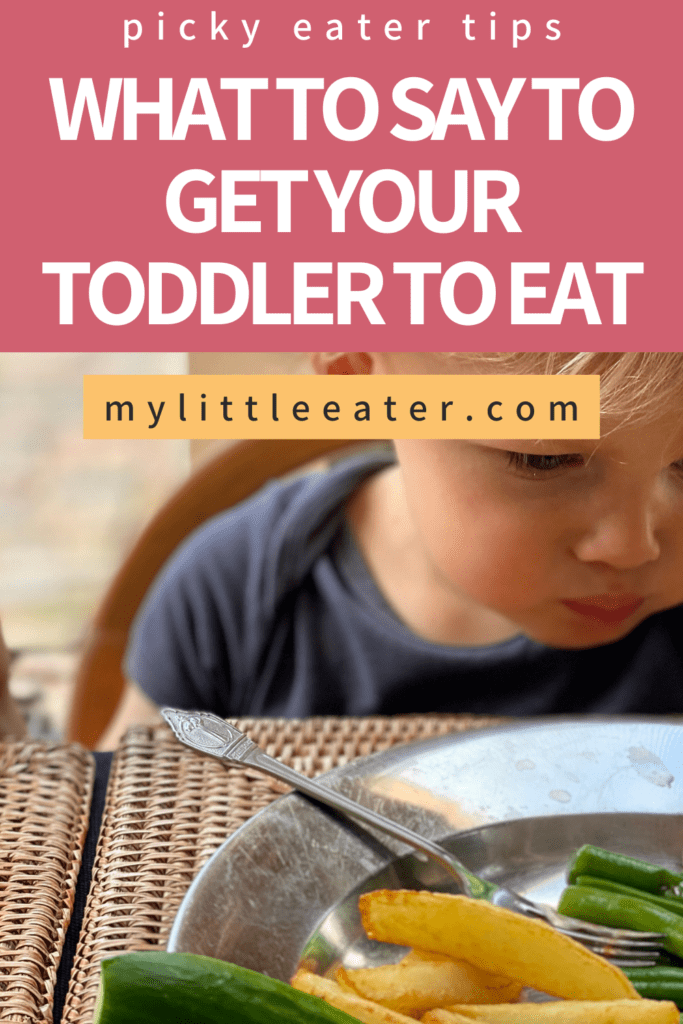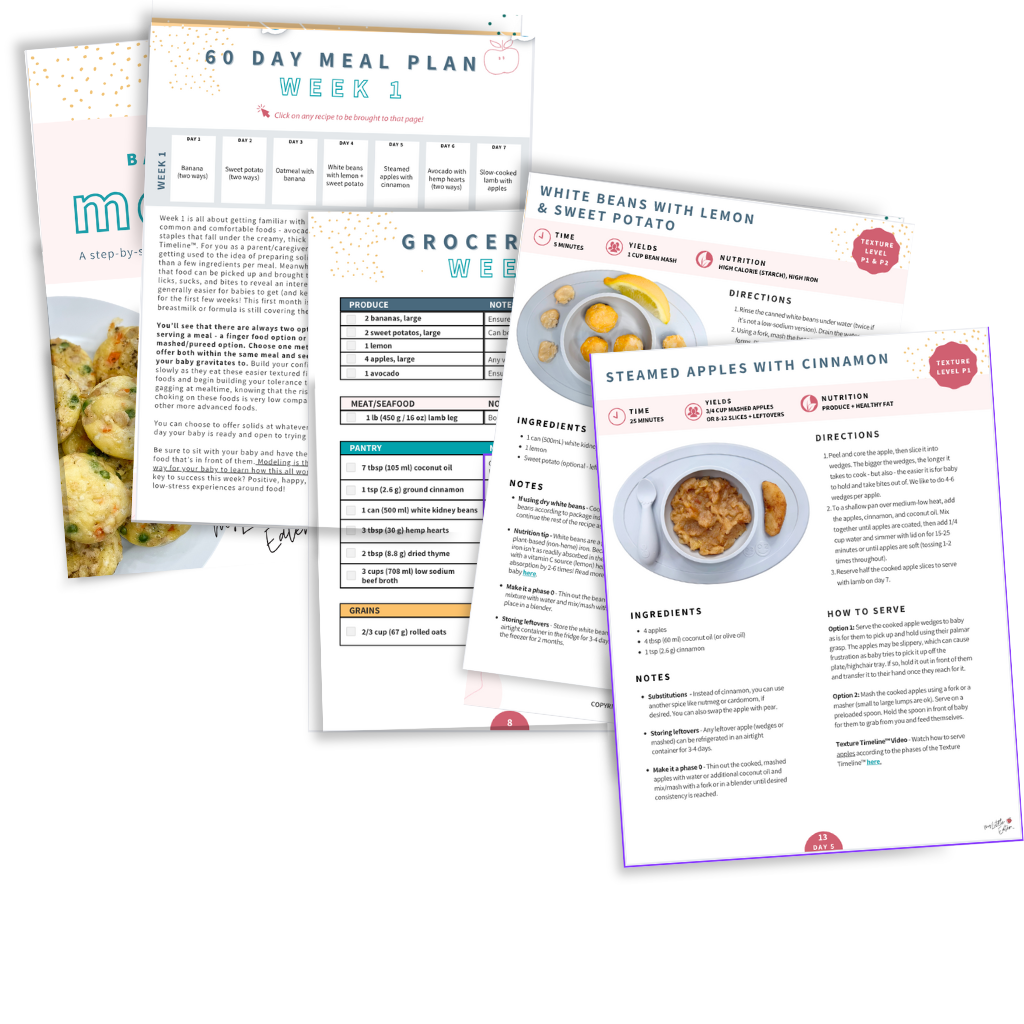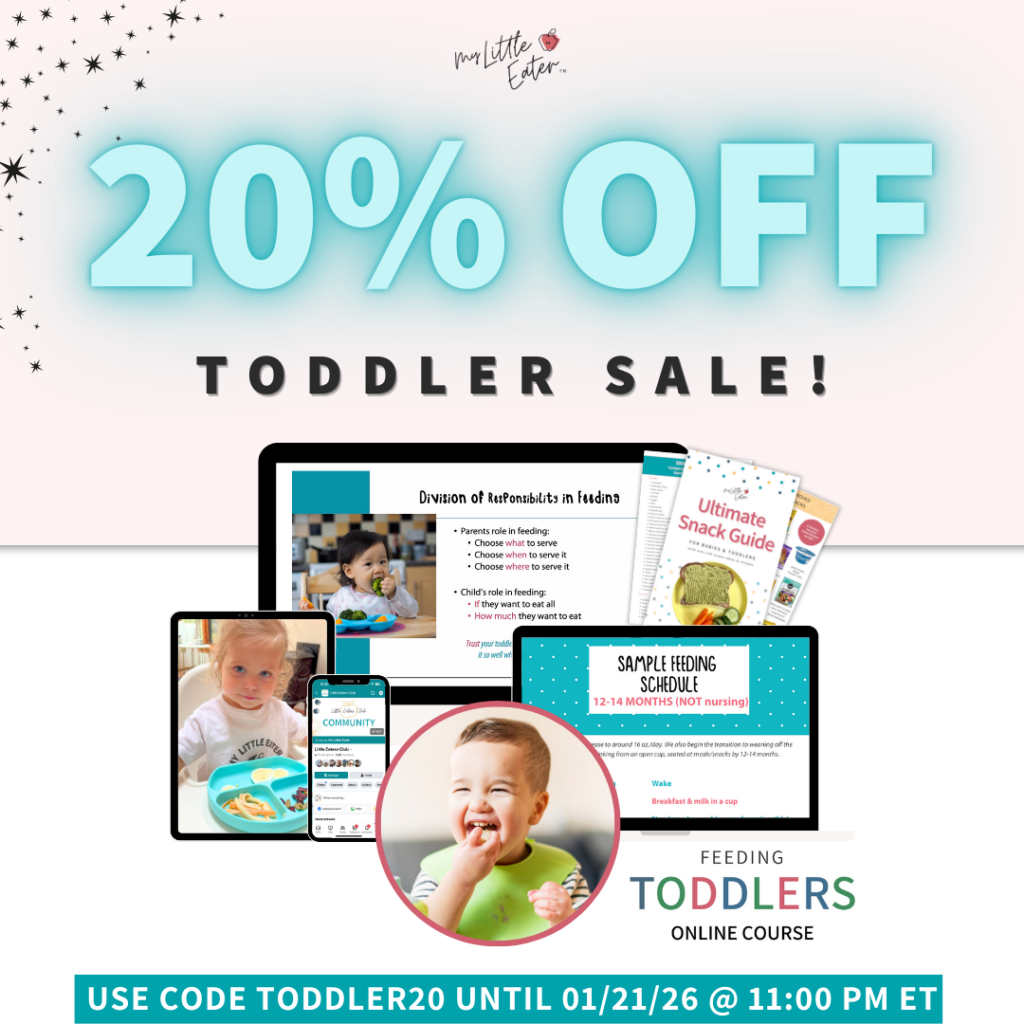Bonus material: 7 Day Toddler Meal Plan
If you have ever Googled “how to get my toddler to eat”, these 7 steps are going to change your mealtimes – forever!
Knowing how to talk to toddlers at meals might seem like a really easy thing for a parent to do. After all, you talk to them all day – or maybe you listen to them talk all day – so it’s easy peasy right? Well…not always!
Pressuring your toddler to eat can happen without you even realizing it, so it’s really important that you learn what will help your toddler relax and try new foods, and what might have the opposite effect. This is what these 7 steps are all about!
Plus, since focusing on your toddler’s picky eating and trying to get them to eat different foods can be stressful…you deserve a break! Download our free 7-day toddler meal plan (with recipes!) to take a week off from worrying about what to feed your toddler.

When your kid won’t eat dinner, it can be really difficult to carry on a conversation and monitor what you say. All you want is to get your toddler to eat, and sometimes we feel that there’s something we can say that will miraculously make our picky toddler start eating.
I hear from many concerned parents who are wondering what to say when their toddler asks this at a meal or says that about what’s being served. Or maybe their toddler seems to have 101 questions during dinner, and they’re wondering how important it is to answer them, how much detail to give, or what’s even considered pressuring or influencing them to eat.
“Why are we having chicken Momma?”
“What kind of sauce is that Daddy?”
“But I wanted french fries!”
“Eww gross, what’s that??”
At least some of these must sound familiar if you’re the parent, or caregiver, to a toddler, especially if that toddler struggles with picky eating.
So how do I recommend you respond?
Well, having been through this phase of toddlerhood with my boys, I know how stressful it is when your toddler won’t eat. So, I have a few tricks up my sleeve that will not only help you manage the constant stream of questions with confidence and ease, but will actually help encourage your toddler to eat their food – without bribing, pressuring, or tricking them to do so!
I’ve also shared all these tips on the podcast, listen below or download it to listen later, if that’s your thing.
Step 1: Do NOT focus on eating or on eating only healthy foods

Let’s start off by saying that I know this is going to be tricky. I also know that you’ve probably heard me talk about the division of responsibility. Basically, you need to let your toddler decide how much to eat, and I know this makes many parents worry. Trust me though, this strategy makes a world of difference when it comes to power struggles and fussy eating.
To be specific, the division of responsibility states that it’s up to your child to decide if they’ll eat anything from what you offer, and how much they’ll eat of what is offered. We let them decide if they want to try a new food, if they want more of the same foods they ate already, if they want to eat less food than usual…all in all they’re listening to their own hunger cues. So it’s not our job to influence them in these areas.
How then do we gently nudge them towards trying certain foods, without actually pressuring them?
Without getting into all the different types of pressure to avoid – I’ve got a blog post on that you can read here for more info – let’s instead talk about what you can do.
You can choose to not focus on eating at all. That’s right. I want you to approach family meals with your toddler with the mindset that this is not about eating and nutrition at all. Shocking coming from a pediatric dietitian, I’m sure!

Instead, I want you to look at family meals as an opportunity to build up their self-esteem, bond and connect, and simply talk with your child.
Yes, having a conversation may be more entertaining, or easy, with a 3 or 4 year old, but I want you to apply this to your mealtimes with your younger toddlers too (for example 13 months old) – even if it’s a very one-sided conversation! Just focus on the conversation, having fun, and enjoying family time together, as best as you can.
So talk. Talk with your spouse or partner, talk out loud to your toddler, and to their siblings. Talk about anything open-ended that takes their mind off food.
No focusing on how much food your toddler eats, or if they skip over the more nutritious food groups on their plate in favor of dessert. Focus and talk about something else entirely – you can do it!
Step 2: Stick to the facts to help your toddler eat

Let’s talk about some specific “What to say when” scenarios.
What to say when serving your toddler their meal
Remember, it’s all about the facts…keep it simple and short.
When you’re serving a family meal, and you put the food on the table, try saying something like…
“We’re having chicken and peas and rice.”
They may ask for more detail, or you can offer it up yourself if you think they’d want to know. This may look like saying…
“This is chicken and it’s marinated in honey and soy sauce.”
What if they ask more questions (as we know some toddlers love to do!)? You could also make a statement about the ingredients. So for example, you could say…
“Honey is a sweet sauce.”
It’s good to describe the properties of food to your toddler, but remember to keep it all about the facts!
What not to say when serving your toddler their meal
Avoid saying anything with your opinion in it.
This includes things like…
“Oh this sauce has honey in it, it’s so delicious.”
“Honey is sweet, you like sweet things, you’re gonna love it!”
Those types of phrases are not strictly factual, they’re more than that, they’re subjective. And subjective statements like that can feel like pressure to your toddler.
Step 3: Describe new foods by comparing them to familiar foods

If your toddler continues to ask more questions, describe the properties and what they can expect from the food. Examples of this include…
“This is rotini pasta, it’s like macaroni, but the shape is different. This is a spiral.”
“This is called an egg roll. It has a crunchy outside and a soft inside.”
Remember, most toddlers have food neophobia (ie. scared of new foods), and therefore are weary of what things are. So bringing in that familiarity by relating one food to another that they know and enjoy, like in the pasta example, will help to decrease that fear of new foods and let them know what to expect. Now, if they respond with something like “I don’t like crunchy food,” you can then respond by saying “That’s ok.”
Here’s the thing though, you can still ask if they want a piece because sometimes they just want to express their feelings and opinions. And even if it sounds like their opinion is that they don’t want any, don’t assume that! They might still be willing to explore it (even if they don’t eat it).
Asking them if they want a piece wouldn’t be considered pressuring because you aren’t trying to influence them. You’ve been very factual when presenting it, and you just want to know if they’d like to have a piece. You’re letting your child decide, which they love to do.
If you need some new meal ideas to try this tip with your picky eater, download my free 7 day toddler meal plan. This meal plan works for toddlers and school-aged children, it includes ideas for healthy snacks and every meal to keep them on a schedule and help build healthy eating habits, plus it includes a grocery list to make shopping easier for you!
Step 4: Keep it short and embrace silence

My next tip is something you’ve probably already noticed me say…try and be as concise as possible with all your answers.
Don’t elaborate too much because this runs the risk that you’ll start to say things that either turn them off, you’ll start to get into health talk or other various forms of pressure. This means that there is no need to explain what is a healthy food vs. what may not be as nutrient dense. They really just want a factual response, and I’m telling you, silence is golden (in this case anyways!).
After using any of the example statements I provided above, I want you to stay silent. Give it some time, pause, see if they respond, and then move on with your conversation. Don’t feel like you have to fill in the gaps when it comes to food talk, or respond to all the comments they make in return, because sometimes that can make things worse.
Step 5: Use these 6 words when they say "I don't like it!"

It’s bound to happen, at some point, your toddler will tell you that they don’t like something. And when they do, how you respond sets the stage for what happens next.
So, when they say they don’t like a food, these are the 6 words that you want to say…
“You don’t have to eat it.”
That’s it.
You can even keep it more simple and say “OK!”
Both of these options are magical at mealtimes because they take away all the power. It shows them that you’re not invested in what or how much they eat, which means that they can’t then struggle to get that power back by refusing to eat something. Because the power isn’t there to begin with. So, remember to use one of these phrases, then pause, don’t elaborate or say anything more in response, and move on with your meal.
Maybe your toddler will pout or become upset and want you to offer food they like because they don’t like that option, but maybe they won’t. Often when you wait, your toddler will start picking at the food, and eventually, they may even end up eating it.
This happens many, many times. It could take as little as 30 seconds, or sometimes after 10 minutes at the table, they’ll finally go for a bite. This is the magic of letting go of that control, letting them realize that mom or dad really doesn’t care if they eat this or not. This signals to them that there are no more power struggles to win here.
Step 6: Respond with empathy toward picky eating

Another helpful thing you can try saying if they don’t like the meal is…
“That’s ok – not every meal is going to be our favorite.”
What you’re doing here is teaching them a lesson that everyone has food preferences. Sometimes you’re going to get your favorite, sometimes you’re not.
You can also say something like…
“Oh, I think this is daddy’s favorite tonight. We can cook one of
your favorites on the weekend.”
This is an example of being empathetic. You’re being respectful to their needs, and taking into account their preferences, without cooking separate meals. And you’re also telling them when they can expect to have their favorite foods so they know it isn’t being withheld from them.
Here are some other examples of how to phrase this…
“I know you love chicken nuggets. I do too! I’m going to put that on
the menu for Tuesday, don’t worry. Tonight we’re having this.”
“I’m sorry you don’t like the meal today. It’s ok if you feel upset about that.”
In many cases, all they want to do is express their feelings and know that they’re being heard, which is completely understandable. But then you’re also moving forward, and setting a boundary so that they can’t step into your role in feeding. Allowing them to make their complaints and express how they feel about what’s being served is a necessary part of processing the information you’re giving them, and that’s ok.
But what do you do if your toddler does pout, or becomes upset, even after you’ve done all the above? It’s bound to happen, so try saying…
“Try and find something at the table to eat, so you can fill your belly
if you’re hungry.”
Don’t elaborate anymore, just move on. It’s their choice after that.
You’ve done your job – remember that.
You’ve provided them with the facts, you’ve been empathetic to their needs, and you’ve directed them toward their options. Now it’s their turn – so be confident and know you’ve done all you can!
Step 7: Remember, they don't have to like everything

One more example of something you can say when your toddler tells you they don’t like something is…
“Oh you don’t like it yet – that’s ok, you may like it soon.”
I’ve included the word yet here because this is going back to the fact that eating is a learning process. Just because your toddler doesn’t like something right now doesn’t mean they won’t like it forever – this is fine!
Not everyone has to like every single food – even adults have foods that they don’t like, or avoid eating when it’s offered to them.
Try teaching them about their taste buds
You can still gently encourage them, and one of my favorite ways to do this with my boys was by teaching them about their taste buds. I taught them that taste buds were the things on our tongue that help us to learn about foods by letting our brains know what it tastes like.
And the most important thing I taught them was that taste buds are always changing. As we grow, we get new taste buds, and so the concept here was that maybe the new taste buds would like this food now, even though the old ones didn’t.
Every so often I’d remind them of this by saying…
“Remember how our taste buds change every couple of weeks? If you
want, you can test out to see if your taste buds have changed, and
grown, or if they’re still the same.”
And then just leave it at that. Let them decide from there if they’d like to test that out or not. Sometimes their curiosity gets the best of them and they decide to give it a try!
BONUS TIP: Your toddler's appetite will change throughout the day and week to week

If your toddler won’t eat, check in with their eating patterns – what did they eat at snack time, when was it, were healthy snacks too close to mealtimes, and how much food did they eat? Make sure they come to the table hungry and let them stop eating if they’re full.
Kids eat according to their hunger cues, so if they aren’t hungry then they will skip a meal, even if it’s dinner time and they usually eat their dinner. Listening to their body like this is a good thing, and we want them to keep these healthy eating habits.
This is why it’s so important to zoom out and consider other factors that may be affecting those eating habits. Many times when a toddler won’t eat one meal if the parent zooms out and considers the rest of the day or even the day before, they see that they have eaten well throughout the day and this one meal being skipped really isn’t a big concern.
Watch the video below to better understand this concept. But in general, toddler appetites fluctuate (just like an adult’s). If your toddler won’t eat a meal – even if they do this for one meal a day – it really doesn’t worry me!
Test out some of these phrases at your next meal as your child eats, and before you know it, this will all be second nature to you! If you’re looking to get a holistic, step-by-step plan for feeding your toddler so that you can have happier mealtimes with them while managing or even preventing picky eating, check out my Feeding Toddlers online course!

Pin these tips to save them for later!


about the author
EDWENA KENNEDY, RD
Founder and lead Registered Pediatric Dietitian at My Little Eater Inc., creator of The Texture Timeline™, and mom of two picky-turned-adventurous eaters.
 toddler sale! 20% off toddler program with code Toddler20 at checkout
toddler sale! 20% off toddler program with code Toddler20 at checkout 








